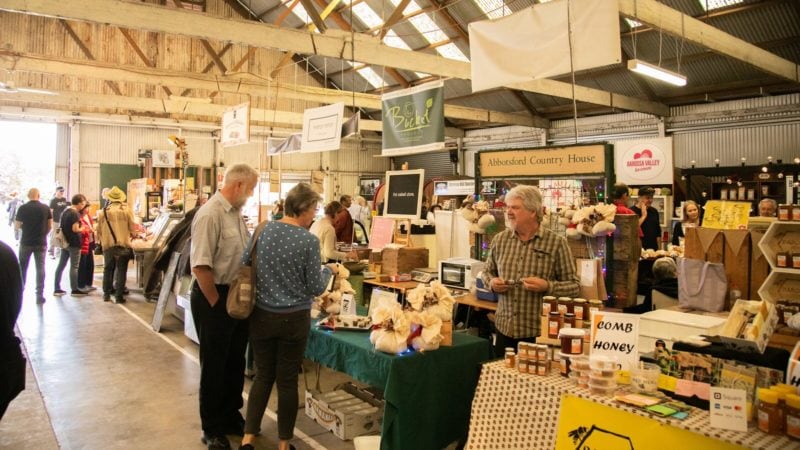The Barossa’s food story: a land of abundance and a cultural melting pot
The Barossa is world famous for its earthy, rich Shiraz and slow food culture developed by generations of farmers, vintners, and home cooks. Over the centuries, this region has remained a place of natural abundance and a melting pot of cultural influence, education, and collaboration.
The Barossa’s location between the Clare Valley (a 90 min drive north), the coastline of the Yorke Peninsula (60 mins west), and the Adelaide Hills (45 mins south) ensured its place as an important trading hub thousands of years before Europeans put their stamp on it. The original food culture of the area belonged to its traditional custodians, the Peramangk, Kaurna and Ngadjuri peoples. The three borders of these nations converged a few kilometres to the west of what is now the village of Nuriootpa.
Each nation had access to abundant resources: the Kaurna people from the plains and coastline, the Ngadjuri from the valleys and ranges, and the Peramangk from the river and hills. Items such as shells, plants, animal skins, stone tools, meat, grubs and bush vegetables were traded between the Peramangk, Kaurna and Ngadjuri peoples for tens of thousands of years.
By the mid-1800s, the same abundance had attracted enterprising Europeans to the area. Among those were English brewer Samuel Smith and Bavarian farmer Johann Gramp, who recognised grape vines would flourish in the Barossa soil and climate. These two men established the Yalumba and Jacob’s Creek vineyards and wineries, contributing to the region’s stellar global wine reputation today.
Many of the workers within those first vineyards were Silesian Lutherans who had emigrated from Prussia to escape religious persecution and poverty. The Lutheran refugees were industrious farmers who were efficient with produce: vegetables were fermented or pickled, meat was smoked, milk was tuned into cheese, the fruit was dried, and, in the specific instance of grapes, fermented into wine.
By the 1850s, local indigenous people had been driven away or their communities decimated by smallpox. More positive records from this time indicate that the Lutheran refugees sought to learn about native ingredients and local cooking practices from the indigenous population.
Barossa historian Dr Angela Heuzenroeder, the author of the 1999 recipe/history book Barossa Food, has documented the range of native ingredients that were not only embraced in European cooking but also by European culture. This includes a tasty native current the traditional owners called kangatta: “Once German-speaking settlers learned about them, they developed a tradition of annual picnics when families would spend a day in the wilderness, gathering the berries to make preserves and cordials.”
As the settlements within the Barossa grew into villages, butchers and bakers, set up shops to cater to the growing population. These Barossa institutions remain must-visit locations for any food-lover, including Apex Bakery in Tanunda, Linke’s Bakehouse in Nuriootpa, and Smokehouse Butchers in Angaston. Their recipes for crusty woodfired bread, chewy honey biscuits and juicy smoked bacon have been handed down for generations and are still enjoyed by Barossa residents today.
And while the Barossa’s reputation as a must-visit food destination continues to be underpinned by the hard-working Lutheran influence, when you delve a little deeper, you will also find lashings of ingenuity, experimentation and, increasingly, a recognition of the skills and practices of the indigenous inhabitants.
Five melting pot Barossa food experiences whilst staying at Barossa Tourist Park
- Otherness Wines, Angaston – located in the quaint main street of Angaston, this light, bright and welcoming bottle shop/delicatessen/wine bar epitomises modern Barossa. Sit at the window and enjoy locally crafted wines, cheese produced just down the road at Barossa Valley Cheese Company, and Trevallie Orchard dried apricots while watching the world (or the occasional world-renowned winemaker or vigneron) go by.

- Green Farmhouse, check the website for Farmer’s Markets. This little family-owned and operated company is based in the Barossa and produces seasonings and salts using native ingredients, including lemon myrtle, wattle seed, muntries and quandongs. They showcase their produce at local markets, including the Mt Pleasant Farmers Market – a 30 min drive from Nuriootpa. Check their website for details: greenfarmhouse.com.au
- Seppeltsfield Road Distillers, Marananga – this picturesque corner of the Barossa is dominated by five kilometres of imposing palm trees, which workers from Seppeltsfield Winery planted during the Great Depression. Established in 2018, Seppeltsfield Road Distillers is a small-batch gin distillery and tasting room that leans into its famous home. Two popular products include the Barossa Shiraz Gin, made from shiraz grapes macerated in gin, and the Native Ground Gin, which features Peppermint Box botanicals from the distillery gardens.
- Barossa Farmer’s Market, Corner of Angaston and Stockwell roads – Established in 2002, not long after Angela Heuzenroeder’s homage to Barossa Food was published, the Barossa Farmer’s Market features seasonal fresh and artisan-made produce from throughout the Barossa and surrounding regions. The markets are every Saturday morning from 7.30am to 11.30am in the sheds of Vintners Bar & Grill: itself one of the Barossa’s best dining experiences. Regular stallholders include iconic and award-winning producers such as Jersey Fresh, Wiech’s Barossa Valley Eggs Noodles and Eleni Barossa Handmade.

- El Estanco, Greenock – The ultimate Barossa melting pot experience, El Estanco is a multi-purpose restaurant/patisserie located in a restored 1890s cottage in the village of Greenock. Launched in 2020 by owners and chefs Abby Osborne and Julian Velasquez, who hails from Colombia, El Estanco melds South American flavours with locally grown and sourced produce and focuses on ethically sourced, environmentally sustainable dishes and practices. The Barossa food experience in a nutshell.
Once you’ve finished exploring the Barossa Valley and its rich history, settle in for the night at BIG4 Barossa Tourist Park
Located in the heart of the Barossa, BIG4 Barossa Tourist Park is situated within 5km of the immersive food and wine experiences listed above.
This luscious, green caravan park features a variety of accommodation options, including powered and unpowered sites, as well as cabins.
